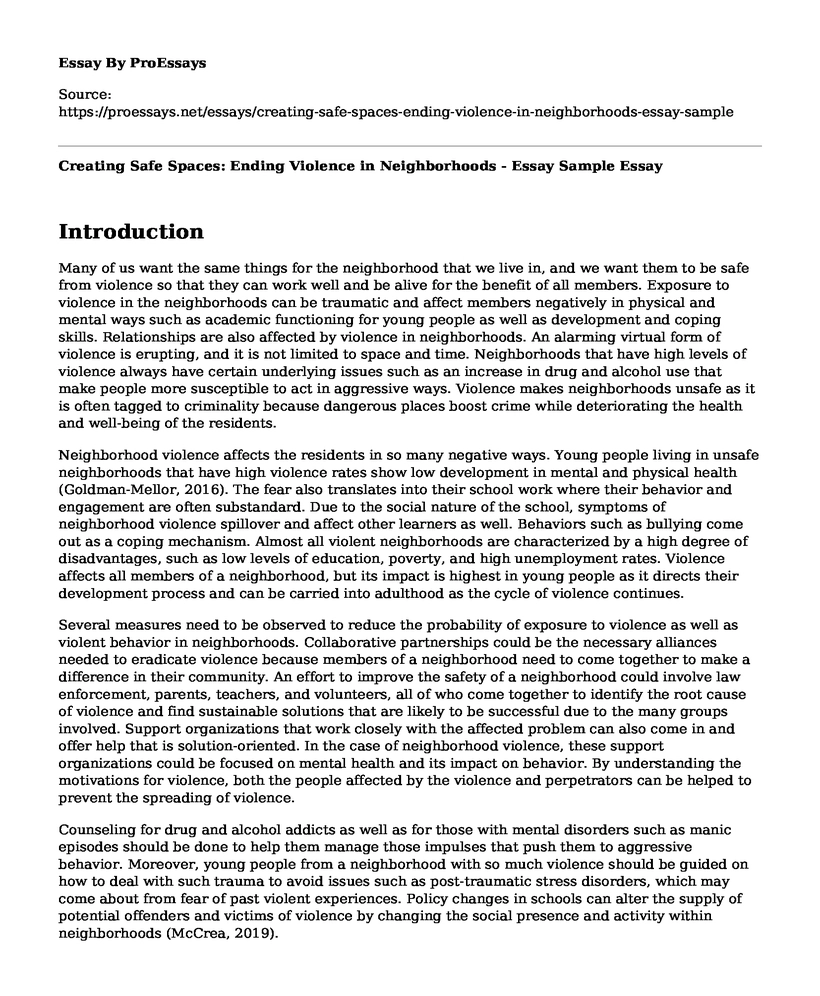Introduction
Many of us want the same things for the neighborhood that we live in, and we want them to be safe from violence so that they can work well and be alive for the benefit of all members. Exposure to violence in the neighborhoods can be traumatic and affect members negatively in physical and mental ways such as academic functioning for young people as well as development and coping skills. Relationships are also affected by violence in neighborhoods. An alarming virtual form of violence is erupting, and it is not limited to space and time. Neighborhoods that have high levels of violence always have certain underlying issues such as an increase in drug and alcohol use that make people more susceptible to act in aggressive ways. Violence makes neighborhoods unsafe as it is often tagged to criminality because dangerous places boost crime while deteriorating the health and well-being of the residents.
Neighborhood violence affects the residents in so many negative ways. Young people living in unsafe neighborhoods that have high violence rates show low development in mental and physical health (Goldman-Mellor, 2016). The fear also translates into their school work where their behavior and engagement are often substandard. Due to the social nature of the school, symptoms of neighborhood violence spillover and affect other learners as well. Behaviors such as bullying come out as a coping mechanism. Almost all violent neighborhoods are characterized by a high degree of disadvantages, such as low levels of education, poverty, and high unemployment rates. Violence affects all members of a neighborhood, but its impact is highest in young people as it directs their development process and can be carried into adulthood as the cycle of violence continues.
Several measures need to be observed to reduce the probability of exposure to violence as well as violent behavior in neighborhoods. Collaborative partnerships could be the necessary alliances needed to eradicate violence because members of a neighborhood need to come together to make a difference in their community. An effort to improve the safety of a neighborhood could involve law enforcement, parents, teachers, and volunteers, all of who come together to identify the root cause of violence and find sustainable solutions that are likely to be successful due to the many groups involved. Support organizations that work closely with the affected problem can also come in and offer help that is solution-oriented. In the case of neighborhood violence, these support organizations could be focused on mental health and its impact on behavior. By understanding the motivations for violence, both the people affected by the violence and perpetrators can be helped to prevent the spreading of violence.
Counseling for drug and alcohol addicts as well as for those with mental disorders such as manic episodes should be done to help them manage those impulses that push them to aggressive behavior. Moreover, young people from a neighborhood with so much violence should be guided on how to deal with such trauma to avoid issues such as post-traumatic stress disorders, which may come about from fear of past violent experiences. Policy changes in schools can alter the supply of potential offenders and victims of violence by changing the social presence and activity within neighborhoods (McCrea, 2019).
Moreover, because drugs and crime predispose neighborhoods to violence, the government should put in place license restrictions for alcohol and firearms so that affected places can be managed. It is important to note that the traditional interventions targeting individuals have not been effective; hence it is time to focus on making changes in the built environment in places where violence occurs frequently.
References
Goldman-Mellor, S., Margerison-Zilko, C., Allen, K., & Cerda, M. (2016). Perceived and objectively-measured neighborhood violence and adolescent psychological distress. Journal of urban health, 93(5), 758-769.
McCrea, K. T., Richards, M., Quimby, D., Scott, D., Davis, L., Hart, S., ... & Hopson, S. (2019). Understanding violence and developing resilience with African American youth in high-poverty, high-crime communities. Children and Youth Services Review, 99, 296-307.
Cite this page
Creating Safe Spaces: Ending Violence in Neighborhoods - Essay Sample. (2023, Jul 04). Retrieved from https://proessays.net/essays/creating-safe-spaces-ending-violence-in-neighborhoods-essay-sample
If you are the original author of this essay and no longer wish to have it published on the ProEssays website, please click below to request its removal:
- Sojourner Truth's "Ain't I a Woman" Essay
- People's Life Experiences and Perspectives Tend To Differ Due to Their Gender - Research Paper
- Areas That Blair-Brown Governments Continue Reverse Conservative Social Policies
- Feminism in Chaucer's "The Wife of Bath" and "The Wife of Bath's Tale"
- Eliminating Gender Bias in the Workplace Paper Example
- Essay Example on Making Foreigners: Exploring American Citizenship & Alienage
- Civil Disobedience - Essay Sample







